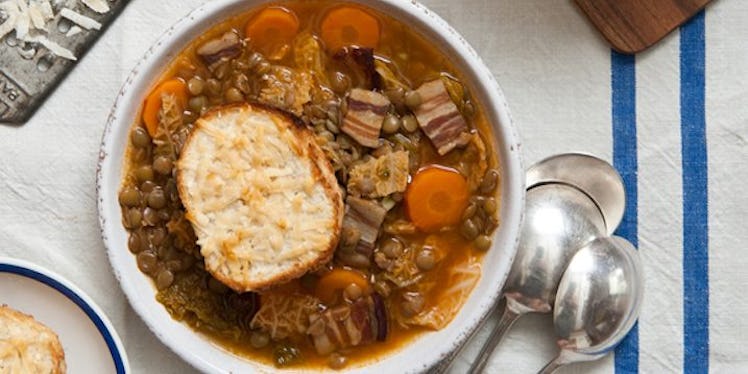Ayurveda is an Indian medicinal system that focuses on balance and encourages you to change your diet with the seasons.
Kind of makes sense, right? When it gets cold, you bundle up.
So, shouldn't you eat differently to also warm up the inside of your body? Yes.
There are three energy principles that Ayurveda uses, which are called doshas.
The dashas are associated with seasons, with spring being represented by Kapha, summer with Pitta and winter with Vata.
Generally, in winter we feel cold. We move less and rest more. Everything slows down a little, and it's a good time to reflect and focus your energy on yourself.
This type of lifestyle can easily lead us to feeling stagnant, so diet is key.
Keeping up with a healthy diet can increase your energy and help you feel good while winter tries to wear you down.
To stay warm, we need to make sure the Vata dasha is balanced. Ayurveda suggests eating sweet, sour and salty foods and avoiding ones that are bitter, astringent, light and cold, as they will push you back out of balance.
Fats and proteins in larger quantities will also help keep you feel grounded and steady.
Here are some foods you can eat that will compliment your winter hibernation vibes and keep your body heat at its optimum level:
1. Iron-rich foods
Hands and feet can be difficult to keep warm during the winter. No matter how many pairs of gloves and socks you pile on, it's tough to fight the chill in these areas.
This can also be a sign of an iron deficiency or anemia, so talk to your doctor if this is a severe problem for you.
Eating foods rich in iron such as lean beef and poultry can help keep those extremities warm. If you're a vegetarian, try lentils, soybeans, tofu, greens, sunflower seeds and pistachios.
2. Citrus fruits
Oranges, tangerines and grapefruit are vital for a winter diet.
They contain Vitamin C, which allows the body to absorb iron and other nutrients. It also supports the immune system to help you avoid annoying colds when everyone around you is sneezing.
The best defense is eating oranges and yelling, “Stay away from me!”
3. Complex carbs
Potatoes, whole grain pasta, oatmeal and sweet potatoes take more energy to break down and digest, making your body work harder, therefore making you warmer.
Fiber is also very important to diet in general, so make sure you're getting enough.
4. Bean soups
Soup is generally both warm and salty, so that checks two items off the list.
Legumes are a great source of iron, and depending on the soup, you can get some complex carbs in there, too.
Try a lentil soup with potatoes, and maybe add some swiss chard or other preferred green for additional iron content.
This is also a perfect time for some root vegetables. Roast some turnips, parsnips and beets to eat by themselves and to throw in the soup.
If you're feeling crazy, add some cinnamon or other sweet and salty flavors.
Soup is great to have on-hand all winter. So, make a giant vat of it and eat it all week. This is the season of being lazy and reheating.
5. Ghee
WTF is ghee? Good question.
Very simply, ghee is clarified butter with only a minute amount of lactose. It is also rich in short and medium-chain fatty acids and butyrate, which is anti-inflammatory and aids in digestion.
Ghee has been used in Indian, Arabic and South Asian cuisine for thousands of years, and it is known as an ancient health food.
It's also highly recommended in Ayurvedic healing because ghee is comforting and warming, and it will keep you feeling balanced.
Plus, how many times are you actually told to eat butter? Almost never.
You should truly take advantage of this because it may never happen again.
